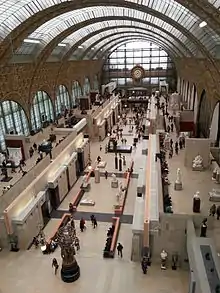
GLAM is an acronym for galleries, libraries, archives, and museums,[1][2] and refers to cultural institutions with a mission to provide access to knowledge. GLAMs collect and maintain cultural heritage materials in the public interest. As collecting institutions, GLAMs preserve and make accessible primary sources valuable for researchers.
Versions of the acronym include GLAMR, which specifies records management,[3] and the earlier form LAM, which did not specify "galleries" (whether seen as a subset of museums, or else potentially confused with commercial establishments where art is bought and sold).[4][5][6] Another form also is GLAMA, which specifies academia,[7] or alternatively GLEAM ("Education").
History
As an abbreviation, LAM has been in use since the 1990s;[8] it emerged as these institutions saw their missions overlapping, creating the need for a wider industry sector grouping. This became apparent as they placed their collections online—artworks, books, documents, and artifacts all effectively becoming "information resources." The work to get GLAM sector collections online is supported by GLAM Peak in Australia[9] and the National Digital Forum in New Zealand.[10]
Proponents of greater collaborations argue that the present convergence is actually a return to traditional unity. These institutions share epistemological links dating from the "Museum" of Alexandria and continuing through the cabinets of curiosities gathered in early modern Europe. Over time as collections expanded, they became more specialized and their housing was separated according to the form of information and kinds of users. Furthermore, during the nineteenth and twentieth centuries, distinct professional societies and educational programs developed for each kind of institution.[11]
Open-GLAM[12] (Galleries, Library, Archives, and Museums) is a term that has gained popularity since 2010 to describe an initiative,[13] network and movement that supports exchange and collaboration between cultural institutions supporting open access to their digitised collections. The GLAM-Wiki Initiative helps cultural institutions share their openly licensed resources with the world through collaborative projects with experienced Wikipedia editors. Open-GLAM and open data resources from the heritage sector are now frequently used in research, publishing, and programming,[14] particularly in Digital Humanities research and teaching.
References
- ↑ "Australian Society of Archivists Annual Conference 2003". Australian Society of Archivists. Archived from the original on August 1, 2003. Retrieved April 18, 2022.
- ↑ "GLAM - CC Wiki". Creative Commons. Retrieved 29 October 2011.
- ↑ "2017 Conference - Australian Society of Archivists". www.archivists.org.au. Retrieved 19 June 2017.
- ↑ BibSI. "On the LAM: Library, Archive, and Museum Collections in the Creation and Maintenance of Knowledge Communities | BibSI". Bibsi.cms.si.umich.edu. Archived from the original on 2014-03-05. Retrieved 2012-04-05.
- ↑ "Homepage". Alaska Libraries, Archives, & Museums. Archived from the original on May 1, 2009. Retrieved April 18, 2022.
- ↑ Jim Michalko (2005-08-04). "LAM DNA". hangingtogether.org. Retrieved 2012-04-05.
- ↑ "DCDC22 Conference". Research Libraries UK. Retrieved 2022-06-02.
- ↑ Information Retrieval & Library Automation. Lomond Systems. 1997.
- ↑ "GLAM Peak — Digital Access to Collections". digitalcollections.org.au. Retrieved 10 Jun 2019.
- ↑ "National Digital Forum". ndf.org.nz. Retrieved 10 Jun 2019.
- ↑ Marcum, Deanna (2014-01-01). "Archives, Libraries, Museums: Coming Back Together?". Information & Culture: A Journal of History. 49 (1): 74–89. doi:10.1353/lac.2014.0001. ISSN 2166-3033. S2CID 144095412.
- ↑ "Open GLAM". Meta.wikimedia.org.
- ↑ "OpenGLAM". OpenGLAM.
- ↑ Henriette Roued (2020). Open Heritage Data: An introduction to research, publishing and programming with open data in the heritage sector. Facet Publishing. ISBN 978-1-78330-360-1. OL 29397859M. Wikidata Q111293389.